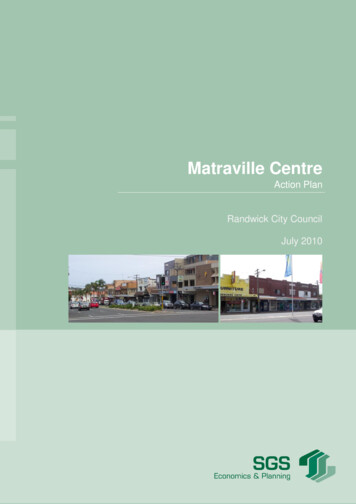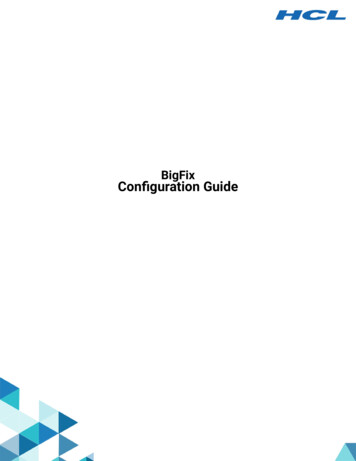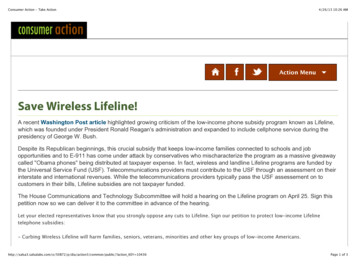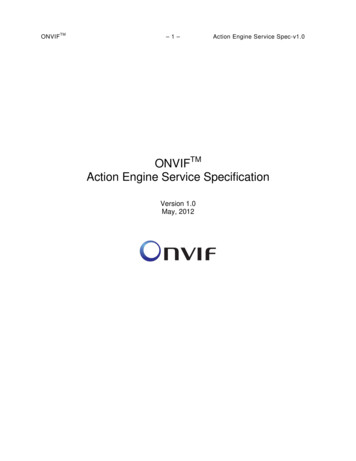
Transcription
Signature Leadership SeriesHealth CareLeader Action Guideto Effectively UsingHCAHPSMarch 2012
Resources: For information related to the patient experience, visit www.hpoe.org.Suggested CitationHealth Care Leader Action Guide to Effectively Using HCAHPS. Health Research & Educational Trust.Chicago: March 2012. Accessed at www.hpoe.orgAvailable at: HCAHPS%20effective%20use.pdfContact: Hospitals in Pursuit of Excellence, hpoe@aha.org, (877) 243-0027 2012 Health Research and Educational Trust. All rights reserved. All materials contained in this publication areavailable to anyone for download on www.aha.org, www.hret.org, or www.hpoe.org for personal, noncommercialuse only. No part of this publication may be reproduced and distributed in any form without permission of thepublisher, or in the case of third party materials, the owner of that content, except in the case of brief quotationsfollowed by the above suggested citation. To request permission to reproduce any of these materials, please emailhpoe@aha.org.1Health Care Leader Action Guide to Effectively Using HCAHPS
Executive SummaryRecent research has demonstrated that an exceptional patient experience correlates with improvedclinical quality, reduced readmissions and improved mortality. HCAHPS is a tool that can be used to helporganizations improve the patient experience, and may have a related effect on clinical quality. With theimplementation of value-based purchasing beginning with October 1, 2012 discharges, HCAHPS performance will also have an impact on financial goals.This guide describes how HCAHPS data should be used in context with other information about organizational performance. It highlights cultural elements necessary to build a firm foundation for HCAHPSsuccess. Once these foundational elements have been considered, the guide outlines a 5-step approach tousing HCAHPS effectively to improve the patient experience, quality and safety:1. Understand HCAHPS data2. Set improvement priorities3. Identify and implement targeted interventions4. Engage the team5. Measure and monitor successThe appendix includes links to white papers and case studies that can help health care leaders betterunderstand the HCAHPS survey and identify and successfully implement strategies for improvement.UnderstandHCAHPS DataMeasure andMonitorSuccessEngage theTeam2SetImprovementPrioritiesIdentify andImplementTargetedInterventionsHealth Care Leader Action Guide to Effectively Using HCAHPSExecutive Summary
IntroductionSince the first public reporting of Hospital Consumer Assessment of Healthcare Providers and Systemsdata by the Centers for Medicare & Medicaid Services in March 2008, HCAHPS data has increasinglygained the attention of hospital leaders. For the first time, hospitals can compare themselves against allU.S. hospitals; and the public can see these data.As pay-for-reporting incentives evolve into pay-for-performance incentives, the needto excel on the survey evolves from a competitive differentiation strategy to a financialHow Can (you)Always Help Patients imperative and a way to improve quality and patient safety. A study of HCAHPS datapublished in New England Journal of Medicine found that hospitals in the top quartile of(and providers) Succeed HCAHPS ratings performed better than those in the bottom quartile, with respect tothe care that patients received for acute myocardial infarction and pneumonia.1Using the HCAHPSdata effectively can help The HCAHPS survey is a tool that, when used correctly, can help hospital leadershealth care leaders posi- identify how to effectively meet their patients’ needs. The CMS HCAHPS websitetion their organizations (www.hcahpsonline.org) reports that more than 7,500 patient complete the surveyand patients for success. each day.Vast numbers of patients are willingly sharing their perspectives, but manyproviders are finding it challenging to use this information effectively. With HCAHPSscores accounting for 30 percent of a hospital’s value-based purchasing score, effectively applying thisdata to improve performance has become even more important.Hospital leaders need to understand how HCAHPS data should be used in context with other information about organizational performance. There are several cultural elements necessary to build a firmfoundation for HCAHPS success. Once these foundational elements have beenHCAHPS survey is aconsidered, hospital leaders can use the following 5-step approach to improve thepowerful toolpatient experience, quality and safety:1. Understand HCAHPS data2. Set improvement priorities3. Identify and implement targeted interventions4. Engage the team5. Measure and monitor successPutting HCAHPS Data in ContextTo understand the dataand maximize its value,it should be used inconjunction with otherinformation that provides a complete pictureof the patient and staffexperience in theorganization.Hospital leaders should use the survey as a tool to strengthen patient relationships and improve care.However, similar to other tools, the data must be applied wisely in order to be effective. The surveyshould not be the organization’s only way of obtaining information about the patient experience. Nor isit intended to be a comprehensive assessment of everything that is important to patients.To get the most value out of the data, it should be considered in conjunction with other organizationalmetrics related not only to the patient experience, but also to the staff experience. To establish itsrelevance with clinicians, survey data should an integral part of hospitals’ quality and safety improvementefforts, rather than simply a measure of customer service. Improving HCAHPS scores should not beviewed as a separate task, but rather within the context of a broader focus.Getting a Broader Perspective of the Patient ExperienceHospitals routinely obtain a wide variety of information from patients and families. Common sources ofpatient/family perspectives include: follow-up phone calls after discharge; patient compliments and1 Ashish K. Jha, MD, E. John Orav, Jie Zheng, Arnold M. Epstein, MD, (2008). Patients’ perception of hospital care in theUnited States, New England Journal of Medicine, 359, 1921-19313Health Care Leader Action Guide to Effectively Using HCAHPSIntroductionPutting HCAHPS into Context
complaints; patient and family advisory councils; patient satisfaction survey comments; letters; and focusgroups. The information obtained from these sources should be combined with HCAHPS data to providea complete picture of the patient experience, highlighting areas of strength and opportunities for improvement.Consideration of the Staff ExperienceImproving the patient experience also depends on the quality of the staff experience. In one study, higherHCAHPS scores were associated with a higher quality nurse work environment and higher nurse-topatient ratios.2 Leaders need to consider data from staff comments and surveys, such as the Agency forHealthcare Research and Quality’s Survey of Patient Safety Culture (see appendix).Making the Connection to Quality and SafetyIn the past, it was common for hospitals to view the HCAHPS survey as a customer-service indicatorthat was not related to clinical outcomes. Research is demonstrating, however, that although patientsmay not have the ability to judge all clinical aspects of their care, their perceptions do reflect importantaspects of quality and safety. A few recent studies highlight opportunities for hospital leaders to integratetheir HCAHPS improvement work with other quality and patient safety initiatives.»» Readmissions: Most hospital leaders regularly scrutinize the organization’s performance on clinicalprocess measures as part of their efforts to avoid preventable readmissions. However, research hasshown that the HCAHPS questions related to discharge information, overall rating and willingnessto recommend are associated with lower 30-day risk-standardized hospital readmission rates afteradjusting for clinical quality.3»» Mortality: In a prior study on acute myocardial infarction, several of the same researchers involvedin the readmissions study (reference above) found that even after controlling for hospitals’ clinicalperformance, “higher hospital-level patient satisfaction scores were independently associated withlower hospital inpatient mortality rates.” In fact, the researchers found that a one-quartile change inpatient satisfaction was associated with an effect on mortality equivalent to a one-quartile change inclinical guideline adherence. Although this study was based on a survey other than HCAHPS, ithighlights the relationship between the patient experience and clinical outcomes. 4»» Other Measures: Another study evaluating the relationship between HCAHPS and other commonquality and safety measures found that that “there were consistent relationships between patientexperiences and technical quality as measured by the measures used in the HQA program, andcomplication rates as measured by the AHRQ Patient Safety Indicators.”5Setting the Stage for Success by Building a Firm FoundationAlthough many organizations focus their HCAHPS improvement strategies on identifying discrete interventions targeting a specific HCAHPS domain, research indicates that HCAHPS success is related tobuilding a culture of patient-centered care. For example, a recent survey found that organizations thatscored both exceptionally and poorly on questions related to overall rating and willingness to recommend had implemented many of the same interventions, indicating that making the improvements specificto the domains were not enough to achieve success.2 Kutney-Lee, A., McHugh, M. D., Sloane, D. M., Cimiotti, J.P., Flynn, L., Neff, D.F., Aiken, L.H. (2009) Nursing: A key to patientsatisfaction, Health Affairs, 28(4) w669-w6773 Boulding W., Glickman S.W., Manary M.P., Schulman K.A., Staelin R., (2011). Relationship between patient satisfaction withinpatient care and hospital readmission within 30 days. American Journal of Managed Care, 17(1), 41-48.4 Glickman S.W., Boulding W., Manary M., Staelin R., Roe M.T., Wolosin R.J., Ohman E.M., Peterson E.D., Schulman K.A., (2010)Patient satisfaction and its relationship with clinical quality and inpatient mortality in acute myocardial infarction. Circulation:Cardiovascular Quality and Outcomes, 3(2), 188-1955 Isaac T., Zaslavsky A.M., Cleary P.D., Landon B.E., (2010) The relationship between patients’ perception of careand measures of hospital quality and safety, Health Services Research, 45(4), 1024-10404Health Care Leader Action Guide to Effectively Using HCAHPSSetting the Stage for Success
Common Characteristics of High-Performing HCAHPS OrganizationsLeadershipPartnership with Patients and FamilySenior leaders are visible and lead by example:Patients and families are treated as partners at everylevel»» Leaders make rounds and speak with patients,families and staff»» Leaders clearly communicate a vision and planfor integrating patient-centered care into dailyoperationsClinicians are engaged in improvement efforts andvisibly support patient-centered carePatient experience is integrated and aligned withother organizational priorities, including quality andsafetyA dedicated champion is in place to support patientcentered careThe organization engages in dialogue with patientsand families on a routine basis using methods otherthan the HCAHPS survey, including:»» Regular rounding with patients to solicit theirperspectives»» Patient and family advisors»» Focus groups»» Post-discharge phone calls»» Organizations identify and respond to patients’individual needsEngaged WorkforcePerformance Improvement FocusStaff members are recruited for patient-centeredvalues and job descriptions, including patient-centereddescription of responsibilitiesPatient-experience metrics are on the organization’sbalanced scorecardOrientation and ongoing training reinforce patientcentered tools and skillsPatient experience is systematically evaluated andfeedback is provided to staffPatient-centered care is rewarded and celebratedData is analyzed to enable organizational learningfrom high-performing unitsCaregivers are supported when challenging situationsarise with patients/families:Performance goals are establishedStaff are actively involved in designing patient-centeredcare processesAccountability and incentives support patientcentered careAn improvement methodology is usedTools, training and support for using data effectivelyfor improvementStaff are encouraged to suggest and pilot improvement ideasSources: Shaller, D., Patient-centered care:What does it take?, The Commonwealth Fund, October 2007., Luxford, Karen, Safran, Dana Gelb, Delbanco, Tom (2011) Promoting patient-centered care: A qualitative study of facilitators and barriers in healthcare organizations with a reputationfor improving the patient experience. International Journal for Quality in Health Care, 23(5) 510—515., Shaller, D., Darby, C., High-performing patientand family-centered academic medical centers: Cross-site summary of six case studies., Picker Institute 2009., Balik B, Conway J, Zipperer L, Watson J.The paper discovered that high-HCAHPS-performing organizations had several traits in common. Overall, interventions were implemented in an effective manner that engaged staff at all levels, focused onorganizational culture, reflected effective partnerships with patients and clinicians and were supported bya commitment of leadership time.6This study is consistent with prior research which showed that patient-centered organizations sharemany common characteristics, including committed leadership, partnerships with patients and familiesand an engaged workforce, as well as effective performance measurement and reporting. Additionally, aliterature review shows that high-performing organizations make sure that patient-centered care isn’t6 The Beryl Institute, The four cornerstones of an exceptional patient experience: focus, accountability, engagement, and commitment,September/October 2010.5Health Care Leader Action Guide to Effectively Using HCAHPSSetting the Stage for Success
just a temporary program, but a core component of the organization’s culture, even reflected in manyorganization’s mission statements. HCAHPS success is dependent upon creating a firm foundation forpatient-centered care that is built on strong leadership, effective partnerships with patients and families,an engaged workforce and a focus on performance improvement.Step 1: Understand HCAHPS DataUnderstanding HCAHPS data requires knowing more than an organization’s current performance on the10 publicly reported HCAHPS indicators. Behind those numbers is a wealth of information that leadersneed to understand and use to guide improvement efforts. Besides the current performance, leadersshould pay particular attention to trending, benchmarking and unit analysis. Further, leaders should payattention to bottom-box performance—the least positive response category on the HCAHPS survey.They should examine if the organization has a higher percentage than the national bottom-box score;this will help set priorities.TrendingAn HCAHPS score reflects how an organization performed during a particular time period. To understand what that data means operationally, it is important to consider historical performance. Trendingagainst prior performance provides leaders with insight into whether performance is improving, holdingsteady or worsening. Leaders should then take appropriate action, such as celebrating improvement, acknowledging consistency or correcting negative changes. Trending can also be used to evaluate the impactof any HCAHPS improvement strategies implemented by the organization and to decide which strategiesshould be replicated throughout the organization.Nationally, HCAHPS scores have improved in all categories. Between the first public reporting period(reflecting October 2006 to June 2007 discharges) and the current public reporting period (reflectingApril 2010 to March 2011 discharges), top-box performance has improved in each of the 10 publiclyreported HCAHPS metrics from one to five percentage points. Top box refers to the most positive response for each HCAHPS question (see table 1).Table 1: Average Top Box ScoresDischarge Information79%Doctor Communication79%Nurse Communication73%Cleanliness68%Willingness to Recommend67%Pain Management67%Responsiveness60%58%Communication about verall Rating68%63%0%20%Most Recent Public Reporting Period (4/2010-3/2011)40%60%80%100%First Public Reporting Period (10/2006-6/2007)Source: Summary of HCAHPS Survey Results. www.hcahpsonline.org/HCAHPS Executive Insight. Public reporting periods, CMS, Baltimore, Page accessed 2/17/126Health Care Leader Action Guide to Effectively Using HCAHPSStep 1: UnderstandingHCAHPS Data
Notably, although top-box performance in all categories has improved, the comparative performanceranking by question has stayed the same with discharge information having the highest score of 82 percent, followed by doctor communication at 80 percent. Communication about medications and quietnesshave the lowest scores of 61 percent and 58 percent respectively. Ironically, discharge information is botha high- and low-performing category. Since the only answer choices for this category are “yes or no,” ithas the highest top-box score and one of the highest bottom-box scores.BenchmarkingIn addition to examining historical and trending performance, understanding HCAHPS requires a comparison of the hospital’s performance to other hospitals. Public reporting and value-based-purchasingperformance are based on comparison to national benchmarks that are comprised of all the hospitals reporting HCAHPS data. Additionally, hospitals may create their own benchmarks using vendor or publiclyreported data. For example, some hospitals benchmark their performance against hospitals in the samestate or against other hospitals of the same type (e.g., academic medical centers or hospitals of a similarsize).Benchmarks should be selected with care, as they typically become the reference pointfor evaluating progress and setting organizational goals. For instance, if percentiles areThere are many ways toused as a benchmark, leaders should realize that this benchmark can vary substantiallyuse the HCAHPS databased on the performance of other hospitals, even if the organization’s performance has to highlight opportuninot changed. In addition, performance in a benchmarking group is often tightly clustered, ties for improvement.so a different answer on a few surveys can result in dramatic swings in percentilesLeaders should ensurethat do not accurately reflect changes in organizational performance. When significantthat the data are usedchanges in percentiles are not related to changes in performance, as reflected in topin a way that is crediblebox scores, they can mislead leaders and frustrate teams who see the performanceand actionable.apparently declining when in fact it has not changed. To get a more complete picture oforganizational performance, percentile benchmarks should be viewed in conjunctionwith actual top-box performance scores.Unit AnalysisAlthough HCAHPS performance is publicly reported as a set of numbers reflecting the performance ofthe hospital as a whole, many hospitals also generate internal reports demonstrating the performance ofindividual units or departments. Analyzing HCAHPS performance on a unit level allows hospital leadersto determine which units are creating a better patient experience and to learn from those units. Leaders should familiarize themselves, not only with their overall scores, but with the unit scores. Analyzingorganization-wide and unit-based data will provide more detail to what is working and not working inparticular areas.However, leaders should exercise caution in making comparisons between units that do not have a sufficient sample size for the data to reliably reflect performance. For example, it is not reliable to comparea 100 percent top-box score on a unit where four patients were surveyed to a unit with a score of 90percent where 100 patients returned surveys. The data based on only four patients is not reliable and willvary dramatically based on who is surveyed. One patient having a different experience would drop thefirst unit’s score from 100 to 75 percent. On the Hospital Compare website, CMS encourages viewers toexercise caution when looking at data that reflects less than 25 completed surveys per quarter (100 peryear).Bottom-Box PerformanceAlthough most hospitals focus on their HCAHPS top-box scores since those are the scores that areused for value-based purchasing and public reporting, reviewing bottom-box scores can provide valuableinformation for setting improvement priorities and measuring progress. CMS publishes the bottom-boxscores on a quarterly basis. In reviewing HCAHPS data, leaders should consider whether there are anyareas in which a larger percentage of patients are giving the organization bottom-box scores than the7Health Care Leader Action Guide to Effectively Using HCAHPSStep 1: UnderstandingHCAHPS Data
national 50th percentile bottom-box scores published by CMS, as this could identify areas that should bea high priority.Step 2: Set Improvement PrioritiesOnce hospital leaders have an understanding of the HCAHPS data within the organizational context, thenext step is to identify improvement priorities. Other than willingness to recommend, performance onall other HCAHPS metrics is incorporated into value-based purchasing. In fiscal year 2013, HCAHPS performance accounts for 30 percent of a hospital’s value-based purchasing payments, with clinical measuresaccounting for the other 70 percent. Because of the financial component, hospital leaders should pursuemultiple improvement initiatives simultaneously. A focused approach to improvement will help to alignefforts and contribute to success.When identifying HCAHPS improvement priorities, health care leaders should consider the value-basedpurchasing implications of the performance and the correlations between HCAHPS measures in conjunction with the opportunities for improvement identified by other feedback from patients, families andstaff.HCAHPS Role in Value-Based Purchasing FY2013Overall rating 3%Discharge info 3%Lowest HCAHPSscore additional6%Pain management3%Clean/quiet 3%Responsiveness3%Commun re: meds3%RNcommunication3%Clinical measures70%MDcommunication3%Value-Based Purchasing ImplicationsIn identifying improvement priorities, one key factor to consider is how the hospital’s performance willaffect payments under the value-based purchasing program. In the fiscal year 2013 value-based purchasingsystem, there are three ways to obtain points:»» Achievement or Improvement: The hospital achieves a certain level of performance compared tonational performance during the baseline period (up to 10 points per measure) OR the hospitalimproves performance compared to its own performance during the baseline measurement period(up to 9 points per measure)»» Consistency: The hospital’s lowest HCAHPS measure compared to national performance during thebaseline period (up to 20 points)8Health Care Leader Action Guide to Effectively Using HCAHPSStep 2: SetImprovement Priorities
Hospitals can earn up to 100 points total on HCAHPS:»» 80 points are available by using the greater of the achievement or improvement threshold for eachmeasure; and»» 20 consistency points are available for exceeding the national median during the benchmark periodfor all HCAHPS dimensions.The hospital’s lowest HCAHPS score has a disproportionate weight to the others—30 of the 100HCAHPS value-based-purchasing points are based on that one measure.In setting HCAHPS improvement priorities, leaders should consider which improvements are likely tohave the most financial value. If the HCAHPS category in which the organization performs the least wellis less than the national 50th percentile for that measure (See middle column of table below), that areawill likely have a significant impact on value-based-purchasing performance and should identified as apriority.VBP FY2013HCAHPS CategoryNurse CommunicationDoctor CommunicationResponsivenessPain ManagementCommunication aboutMedicinesClean/QuietDischarge InformationOverall Rating“Top Box” Minimum Score Required for:Any Achievement/FullMaximumAny Consistency Consistency Points on LowestAchievement PointsPointsHCAHPS Measure(Benchmark - mean(Minimum)(Achievement Threshold - 50thof top .4729.3262.8081.9366.0277.6489.0985.52Source: Federal Register, 76 (88) 2001.CorrelationsCMS publishes an annual correlations table that demonstrates how the HCAHPS metrics relate to oneanother. When setting improvement priorities, health care leaders should consider how improvement inone area is likely to affect performance in other areas. For example, the current CMS analysis demonstrates that the three strongest drivers of overall rating are nurse communication,The impact of HCAHPS pain management and responsiveness.performance on valueIn addition to considering the CMS correlations table, those hospitals usingbased purchasing,especially the dispropor- survey-vendor questions in combination with HCAHPS questions should considertionate weighting of the any analysis provided by their vendors on questions that correlate with HCAHPSlowest HCAHPS dimen- performance. Examination of these drivers, such as questions about the courtesysion, should be consid- and respect of hospital personnel, help hospital leaders understand what is drivingered in setting priorities. HCAHPS performance. They can then create specific action plans to improve thepatient experience.9Health Care Leader Action Guide to Effectively Using HCAHPSStep 2: SetImprovement Priorities
Although lessons can belearned from other orOrganization- and Unit-Specific Prioritiesganizations’ experiences,Just as an understanding of HCAHPS performance requires an examination ofmany insights can be gainedboth individual, unit and the organizational performance, leaders should considerinternally by comparingsetting organization- and unit-specific improvement priorities. For example, ifunit performance, identifynurse communication is identified as an organization priority, and there are a fewing differences, learningunits with exemplary nurse communication scores, those units should have thefrom prior experiences andability to select a different priority for their improvement work. Priorities shouldsoliciting and respectingbe integrated and aligned with other organizational priorities and developed infrontline wisdom.conjunction with input from staff.Step 3: Identify and Implement Targeted InterventionsAfter identifying priority areas for improving the patient experience, organizations should determineperformance-improvement interventions. Choosing interventions should involve a combination of external and internal review.External ReviewIn selecting improvement interventions, leaders should consider the successful practices that other organizations have implemented. Many published case studies (summarized in the appendix) describe whatorganizations have done to improve HCAHPS performance. Organizations should review successful andunsuccessful process and common characteristics of hospitals that have already improved their HCAHPSperformance. Simply deciding to adopt a practice is not enough. Careful attention must be paid to howto do it consistently and effectively in each organization.Since HCAHPS is a relatively new survey, additional research and case studies are being released on aregular basis. Leaders should monitor emerging developments, such as through the Agency for Healthcare Research and Quality’s Innovation Exchange (www.innovations.ahrq.gov) and the AHA’s Hospitalsin Pursuit of Excellence (www.hpoe.org) which regularly profiles organizations implementing innovativepractices to improve the patient experience. Promising practices identified by existing articles and casestudies include:»»»»»»»»»»Leadership roundingHourly nurse roundingBedside change of shift reportingPatient and family advisory councilsPost-discharge phone calls»» Project RED (ReEngineering hospital Discharge)»» Sleep aids (e.g. headphones, ear plugs, soothingsound generators)»» Patient-friendly daily medication schedule andteaching cards on common new medications»» Communication tools for patients/families duringtheir stay (e.g. notepads, white boards)Internal ReviewIn selecting improvement interventions, leaders should actively tap into the expertise within their ownhospital (or, if applicable, within the other hospitals in their system). Leaders should familiarize themselves with the differences in practices between high- and low-performing units in the priority area todetermine if there are unit-based innovative practices that could be replicated throughout the organization. Team trades, where a staff member from a high-performing unit exchanges places with a colleague ina low-performing unit for a few hours, can be an effective way of identifying the differences between theunits.Understanding Organizational HistoryLeaders also should familiarize themselves with what interventions have previously been attempted inthe organization, both successful and unsuccessful interventions. For example, if hourly rounding wasstarted and then stopped, it is important for leaders to understand the barriers that impeded successfulimplementation and to determine how to avoid them in future implementation.10Health Care Leader Action Guide to Effectively Using HCAHPSStep 3: Identify and ImplementTargeted Interventions
Step 4: Engage the TeamHCAHPS success depends not only understanding the data, bu
HCAHPS scores were associated with a higher quality nurse work environment and higher nurse-to-patient ratios.2 Leaders need to consider data from staff comments and surveys, such as the Agency for Healthcare Research and Quality's Survey of Patient Safety Culture (see appendix). Making the Connection to Quality and Safety










